From Guest Blogger R. Hoyal: Solar Energy Hotels — The Future Is Bright
The resort and hotel business is extremely competitive and costly. As more and more hotels become increasingly extravagant, they require evermore energy to run. Many are switching to green renewable energies to cut costs and in theory they could eventually become self-sufficient, or even produce an energy surplus. The easiest way to start to do this is with the addition of solar power.
Solar Valley Micro-E
This is the largest solar-powered hotel in the world. Recently opened in Dezhou City, China, the grand entrance to this hotel is almost completely covered in solar panels. The hotel itself spans about 75,000 square meters and is covered in thousands of permanent panels that are worked into the very design of the building itself. Despite how large the total area is the solar energy created, ensures that the hotel can take care of 70% of its energy needs. This energy is used for almost all the hotel functions such as water heating and air conditioning.
Hyatt Regency: New Brunswick
The Hyatt Regency in New Brunswick, New Jersey USA has recently installed a 32,000 square foot solar panel system capable of generating 421 kilowatts of power. This system should save around 750 barrels of oil a year. It will also reduce the carbon dioxide produced by around 10,000 tons over the next 30 years. These numbers can only improve, as solar power becomes more popular and more efficient. This means 40 to 50% of the hotel’s power is solar, taking care of all the water heating and all of the electrical appliances.
Joie De Vivre: Hotel Carlton
In San Francisco, California, the Joie de Vivre Hotel Carlton has installed 105 solar panels as part of its eco-friendly initiative. Even this small number of solar panels has helped reduce the hotel’s total energy cost by 12% and provides more than 9% of its electricity. This is estimated to cut down the carbon footprint by 33,000 pounds each year. Guests are encouraged to watch and monitor how these savings and energy production methods are working via monitors set up in the hotel’s lobby.
Crowne Plaza
Down under in Alice Springs, Australia is the Crowne Plaza, the first part of a solar energy project for the city. The update to the hotel’s power grid includes over 1300 photovoltaic modules. These solar cells supply up to 80% of the hotel’s power. This has cut down not only on the hotel’s costs and power needs, but the whole city now requires 0.5% less power from this one set of panels alone.
Boutique Hotel Stadthalle
Located in Vienna, Austria, the Boutique Hotel Stadthalle has fully embraced the advent of solar energy technology. Its power needs are 100% supplied by solar energy – the first hotel in all of Europe to have an energy balance of zero. This is one of many other environmental features the hotel has, including recycling rainwater and roof top gardens, one of which is the largest lavender field in all of Vienna.
It is encouraging to see such profit-driven establishments taking new positive steps to reduce environmental damage. Whilst these hotels are leading the green way, they are not necessarily always expensive to visit. If you are thinking of taking a break somewhere where your conscience can sleep easy, there are plenty of offers available for those who need a holiday loan. The more of us that choose to visit such places, the more the cost will be reduced over time and hopefully the industry will begin to follow in the footsteps of these pioneers.


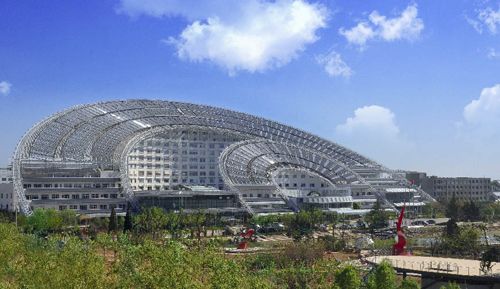
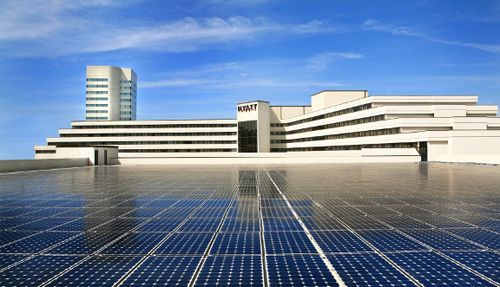
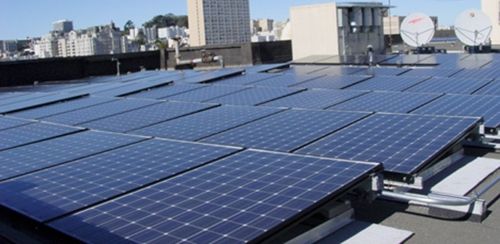
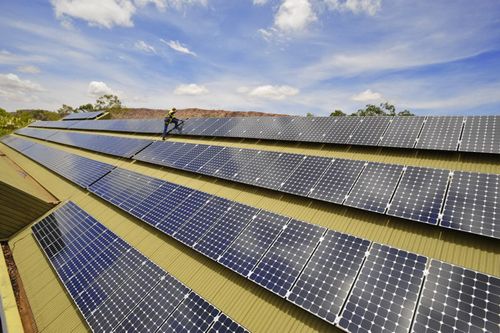
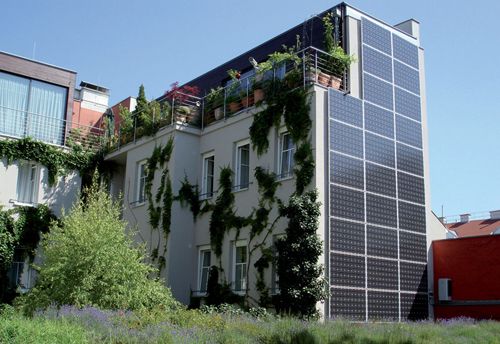
Even though you may hate the fact that Sheldon Adelson is a major contributor to the Republican party the fact of the matter is that one of his casinos in Las Vegas has one of the largest solar thermal systems in the country:
http://sands.com/sands-eco-360/our-properties/
I cannot believe that they are using PV panels for water heating especially considering their cost and the fact that their efficiency is only about 15% compared with the 50%+ efficiency of flat panel collectors to heat water.
Also, the article says nothing about energy storage. Surely hotel power is required 24 hours per day.
They aren’t. They have a thermal and a photovoltaic system.
It makes sense for them to have thermal systems. PV panels tend to be oversold and panels for heating water tend to be undersold.
I couldn’t agree more 🙂
Even better would be hybrid solar panels (water cooled PV) as these produce more electricity than standard panels and supply a significant contribution to hot water.
Water cooled PV panels were experimented with many years ago, but I don’t know anything about their current status. It would seem to make sense. However, I don’t know how hot they can be operated without damaging the PV material. For water heating, probably the minimum acceptable temperature would be about 120F, but in some situations, perhaps temperatures greater than 150F would be required.
Obviously they could be used for swimming pool heating since in that application, temperatures would be less than 100F.
It’s surprising that more work has not been done on that.
Hey Frank,
Here is a company called Naked Energy (no relation) that is working on a hybrid solution:
http://www.nakedenergy.co.uk/product/how-it-works/
“Nakedenergy” mentions heat-driven cooling systems. No doubt they are referring to absorption systems, probably the lithium bromide / water system which has been around for many decades and is in widespread commercial use. A Japanese company was or is working on a solar-driven system for domestic air conditioning. Whether the cost can be made low enough for it to be economically justifiable I don’t know, but it would seem to have potential. It requires some power to drive pumps. Unfortunately, the COP of such systems is generally < 1 which may be a problem, but electric air conditioning is not very efficient either when the losses in power generation and distribution are considered.
we can’t we find solar thermal installation? this is a cheap and proven technology
Solar thermal goes back to some time before 1920. Before natural gas became readily available, solar water heaters were common in California. It certainly is true that it is a cheap and proven technology. It’s astonishing that it isn’t more common here in the U.S. It is, however, common in some countries.
Solar Thermal has been mandated by planning laws in Israel for decades wherever technically possible. There are now also similar laws in parts of Spain, and I think in Cyprus.
When I lived in Fiji (1994 – 2004), I had a solar water heater. Rarely did I have to use the electric back-up heater. It was a system that was commonly used in Fiji, but probably would not be acceptable here.
There was a tank on the roof that was kept filled by means of a float valve. The water in the tank was heated by solar panels using thermo-syphon and the hot water was fed to the house by gravity so the pressure was low. There was an electric heater in the tank that I could turn on if necessary, but it was seldom required.
There are better solar water heater systems available than what I had and they should be encouraged.
There are different solar thermal systems for different situations.
In hot desert locations, you can pretty much get away with a black barrel on the roof with simple mirrors, or a system circulating water through black hoses.
Moving away from such situations requires increasingly sophisticated solutions.
A typical solution for generally sunny locations not usually prone to frost is an evacuated tube solar thermal system with integrated hot water tank in the heating manifold, or flat plate variants of the same idea. Water heating is direct.
Moving to cooler climates,or locations with hard water it becomes necessary to split the system into two parts.
Part 1. The solar collector flat plate or evacuated tube.
Part 2. An indoor hot water tank.
An antifreeze solution is circulated through either the heating manifold (evacuated tube), or the panel (flat plate), with heat transferred to the hot tank using a heat exchanger. Water heating is indirect.
For much larger systems used for process heat – such as might be used for commercial cooking, concentrated solar thermal solutions using parabolic mirrors focussed onto a heat pipe can be considered – with the system either directly or indirectly producing steam.(Such systems are sometimes used for temple cooking in India).
Do I use all hotel only solar system in hot country